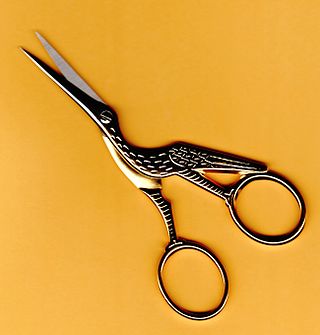In linguistics, a noun class is a particular category of nouns. A noun may belong to a given class because of the characteristic features of its referent, such as gender, animacy, shape, but such designations are often clearly conventional. Some authors use the term "grammatical gender" as a synonym of "noun class", but others consider these different concepts. Noun classes should not be confused with noun classifiers.
In grammar, a noun is a word that represents a concrete or abstract thing, such as living creatures, places, actions, qualities, states of existence, and ideas. A noun may serve as an object or subject within a phrase, clause, or sentence.
In linguistics, a mass noun, uncountable noun, non-count noun, uncount noun, or just uncountable, is a noun with the syntactic property that any quantity of it is treated as an undifferentiated unit, rather than as something with discrete elements. Non-count nouns are distinguished from count nouns.
In linguistics, measure words are words that are used in combination with a numeral to indicate an amount of something represented by some noun. Many languages use measure words, and East Asian languages such as Chinese, Japanese, and Korean use them very extensively in the form of number classifiers.
English grammar is the set of structural rules of the English language. This includes the structure of words, phrases, clauses, sentences, and whole texts.
The plural, in many languages, is one of the values of the grammatical category of number. The plural of a noun typically denotes a quantity greater than the default quantity represented by that noun. This default quantity is most commonly one. Therefore, plurals most typically denote two or more of something, although they may also denote fractional, zero or negative amounts. An example of a plural is the English word cats, which corresponds to the singular cat.

The modern Chinese varieties make frequent use of what are called classifiers or measure words. One use of classifiers is when a noun is qualified by a numeral or demonstrative. In the Chinese equivalent of a phrase such as "three books" or "that person", it is normally necessary to insert an appropriate classifier between the numeral/demonstrative and the noun. For example, in Standard Mandarin, the first of these phrases would be 三本书 sān běn shū, where sān means 'three', shū means 'books', and běn is the required classifier. When a noun stands alone without any determiner, no classifier is needed. There are also various other uses of classifiers: for example, when placed after a noun rather than before it, or when repeated, a classifier signifies a plural or indefinite quantity.

The grammar of Standard Chinese shares many features with other varieties of Chinese. The language almost entirely lacks inflection; words typically have only one grammatical form. Categories such as number and verb tense are often not expressed by grammatical means, but there are several particles that serve to express verbal aspect and, to some extent, mood.

A plurale tantum is a noun that appears only in the plural form and does not have a singular variant for referring to a single object. In a less strict usage of the term, it can also refer to nouns whose singular form is rarely used.
A classifier is a word or affix that accompanies nouns and can be considered to "classify" a noun depending on some characteristics of its referent. Classifiers in this sense are specifically called noun classifiers because some languages in Papua as well as the Americas have verbal classifiers which categorize the referent of its argument.
In French, articles and determiners are required on almost every common noun, much more so than in English. They are inflected to agree in gender and number with the noun they determine, though most have only one plural form. Many also often change pronunciation when the word that follows them begins with a vowel sound.
An indefinite pronoun is a pronoun which does not have a specific, familiar referent. Indefinite pronouns are in contrast to definite pronouns.
Fewer versus less is a debate in English grammar about the appropriate use of these two determiners. Linguistic prescriptivists usually say that fewer and not less should be used with count nouns, and that less should be used only with mass nouns. This distinction was first suggested by the grammarian Robert Baker in 1770, and it was eventually presented as a rule by many grammarians since then. However, modern linguistics has shown that idiomatic past and current usage consists of the word less with both count nouns and mass nouns so that the traditional rule for the use of the word fewer stands, but not the traditional rule for the use of the word less. As Merriam-Webster's Dictionary of English Usage explains, "Less refers to quantity or amount among things that are measured and to number among things that are counted.”

The articles in English are the definite article the and the indefinite articles a and an. They are the two most common determiners. The definite article is the default determiner when the speaker believes that the listener knows the identity of a common noun's referent. The indefinite article is the default determiner for other singular, countable, common nouns, while no determiner is the default for other common nouns. Other determiners are used to add semantic information such as amount, proximity, or possession.
In linguistics, universal grinder is the idea that in some languages, most count nouns can be used as if they were mass nouns, which causes a slight change in their meaning. The term "universal grinder" was first used in print by F. Jeffry Pelletier in 1975, after a personal suggestion by David Lewis.

English nouns form the largest category of words in English, both in terms of the number of different words and in terms of how often they are used in typical texts. The three main categories of English nouns are common nouns, proper nouns, and pronouns. A defining feature of English nouns is their ability to inflect for number, as through the plural –s morpheme. English nouns primarily function as the heads of noun phrases, which prototypically function at the clause level as subjects, objects, and predicative complements. These phrases are the only English phrases whose structure includes determinatives and predeterminatives, which add abstract specifying meaning such as definiteness and proximity. Like nouns in general, English nouns typically denote physical objects, but they also denote actions, characteristics, relations in space, and just about anything at all. Taken all together, these features separate English nouns from the language's other lexical categories, such as adjectives and verbs.

In English, possessive words or phrases exist for nouns and most pronouns, as well as some noun phrases. These can play the roles of determiners or of nouns.

English determiners are words – such as the, a, each, some, which, this, and numerals such as six – that are most commonly used with nouns to specify their referents. The determiners form a closed lexical category in English.
LFN has an analytic grammar and resembles the grammars of languages such as the Haitian Creole, Papiamento, and Afrikaans. On the other hand, it uses a vocabulary drawn from several modern romance languages – Portuguese, Spanish, Catalan, French, and Italian.
A bare noun is a noun that is used without a surface determiner or quantifier. In natural languages, the distribution of bare nouns is subject to various language-specific constraints. Under the DP hypothesis a noun in an argument position must have a determiner or quantifier that introduces the noun, warranting special treatment of the bare nouns that seemingly contradict this. As a result, bare nouns have attracted extensive study in the fields of both semantics and syntax.



